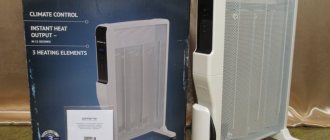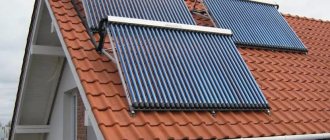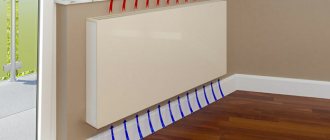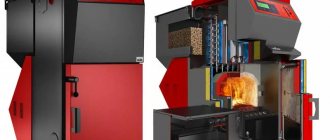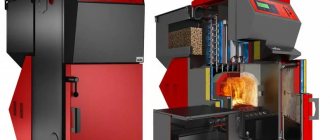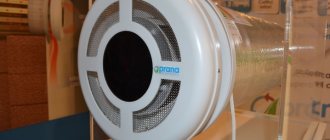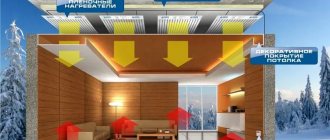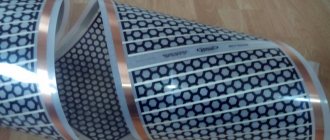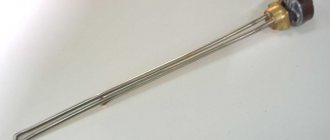Often, choosing heating for a private home confuses people. Dazzling advertising promises reliability, cheapness and comfort at the same time. In most cases, painfully familiar and outdated heating systems are served under this sauce: gas, diesel, electric. Nothing new except the wrapper! But the future has already arrived and all this has a worthy alternative.
Technological Electrolux inverter convectors, produced by one of the leaders in this field, serve as the basis for creating an inexpensive and, most importantly, highly efficient heating system. The inverter system has a number of undeniable advantages compared to heating with an electric boiler with water radiators.
Inverter heating system based on Electrolux convectors with digital INVERTER control unit and WiFi module
What is an inverter
An inverter is a device that converts direct electric current into alternating current or increases the voltage and frequency of alternating current.
The need for such a transformation arises when creating devices and mechanisms with a sensitive system of settings that respond to the slightest change in environmental parameters. Inverters are used in many areas: electric welding (in fact, a welding machine is a type of inverter), control of electric motors and electric drives, production of air conditioners and heaters, etc. As an integral part of the device, inverters look different and can be customized not have.
How does inverter heating work?
When organizing home heating by any means, it is necessary to insulate the premises as much as possible. Proper thermal insulation of building envelopes is the main condition for the energy efficiency of any heating and ventilation system. It is also necessary to protect the metal elements of the equipment from corrosion if the boiler design involves heating the coolant from heating elements: in this case, the liquid should not get on the thermoelements. But a more modern inverter boiler does not have the design flaws that heating element boilers have.
An induction boiler, as its name suggests, works using the principle of electromagnetic induction. Modern boiler models have built-in batteries, and the boiler can operate fully in conditions of unstable power supply. Houses connected to sections of the network where outages, breakdowns and voltage fluctuations are frequent can be heated with induction boilers, and the operation of these boilers is quite convenient.
Main elements of induction boilers:
- Heat exchange circuit in which the coolant is heated
- Inductor coil, or inverter. It can work both from the mains and from batteries. The alternating magnetic field causes heating of the heat exchanger and coolant, which is then sent to the circulation system
A little more about the design of an induction boiler:
The case has several layers - inside there is a core with a double wall, then electrical and thermal insulation, then the outer layer of the case. Industrial boilers had a cylindrical core winding, but domestic inverter boilers are designed with a toroidal copper winding. Two thick-walled (wall thickness from 1 cm) ferromagnetic pipes connected by welding form an inductor, and the magnetic core, or core, is an outer pipe of a larger diameter, having a toroidal winding of copper wire. The inner pipe is a heating element for the coolant fluid.
Boiler operation: the coolant can be either water or antifreeze. The liquid passes into the boiler through an inlet pipe welded through the heating pipe and magnetic circuit. The internal area of the heat exchange pipe is large enough, so more than 95% of the thermal energy generated by the boiler is transferred to the coolant. The inertia is significantly less than when heated by heating elements, therefore the heating time is shorter. The work is based on the use of electromagnetic induction - an alternating high-frequency magnetic field generates an induction current. In turn, the induction current heats the material of the core pipe, since eddy currents arise in the ferromagnet. Scale is not deposited on the pipe surfaces, since high-frequency vibrations of the walls prevent this. External thermal and electrical insulation creates protection against current leakage and minimizes heat loss.
The complete set of inverter boilers includes: an inverter converter based on semiconductors, through which the boiler receives power (alternating current) and a control unit with automatic switches; the boiler body has a built-in temperature sensor for an electronic thermostat.
The coolant in the inverter boiler is heated from a steel magnetic core-pipe. High voltage currents generate an electromagnetic field, and the ferromagnetic core is quickly heated by Foucault currents (or eddy currents). The boiler operation cycle can be described in a little more detail as follows: connecting the power supply - the primary toroidal winding is powered by high voltage current - the core pipe is heated, from the outside inwards, as a result of the action of the electromagnetic field, “pressing” eddy currents into the outer surfaces of the pipe - from The heated core receives heat from the circulating coolant - transport of the heated coolant to the heating radiators. The operating temperature of the inverter boiler core pipe is 75 degrees, and it only takes about 6-8 minutes to heat up to operating temperature.
The use of inverters in heating
In the production of heating devices, inverters are used as a device that allows precise pre-setting or adjustment during operation of the unit.
High-tech electric heating devices that do not have heating elements, lamps, filaments and heating coils in their design necessarily include inverters as devices for increasing the functionality and efficiency of the heating unit. Such heating means include vortex induction heaters (VIN) and inverter air conditioners. Both of these devices are descended from their less advanced predecessors: VIN - from induction boilers of the SAV type, inverter split systems - from conventional air conditioning systems.
Installation
Installing an induction boiler yourself will not cause much trouble. You just need to follow a few rules:
- do not forget about the mandatory installation of an expansion tank and, in most cases, a circulation pump in the system;
- the power supply network and wiring must correspond to the power of the device; automatic protective equipment will not be superfluous;
- the boiler should be placed at a certain distance relative to the nearest objects;
- The device must be grounded.
Methods for installing inventory heaters
The absence of the need to equip a separate room for an induction boiler, its ease of maintenance, safety, noiselessness and other numerous advantages give this device an undeniable advantage over other devices of similar purpose.
Equipping it with something like an electronic programmer will also allow you to remotely control the heat in your home, which may be a pleasant addition for owners of periodically visited country houses.
How it works: device and principle of operation
In heaters, the operation of the inverter is tied to controlling the ambient temperature and optimizing heat flow. The principle of operation can be clearly seen by comparing the operation of a simple heater (A) and an inverter heater (B).
- Simple heater:
- when connected to the network, the device heats the air to the value set by the user;
when the temperature exceeds the temperature sensor, the device turns off;
- After some time, the air in the room cools down and the unit turns on at full power.
- Inverter heaterThe inverter is built into the control unit, where it converts alternating current into direct current and back into alternating current, but at the required frequency.
- When turned on, the heater brings the air to the user-set value;
- when the desired temperature level is reached, the operating power is automatically reduced - to 5-10 percent of normal power;
- In this way, the temperature will drop at a slower pace and heating will start when the set value is passed.
The consequences of cyclic on-off switching are a jump in power consumption in the network, maximum load on the device during startup and wear of parts.
The figure shows a comparison of the operation of a conventional air conditioner and an inverter.
Principle of operation
Inverter heaters operate on a very simple principle, which is to convert direct current into alternating current, thereby changing the frequency and voltage. The operation of an inverter is very similar to that of an air conditioner. The main structural element is a pump, consisting of internal and external blocks. The internal one contains a heat exchanger in which freon accumulates under the influence of high pressure. Its temperature can reach up to 80°C.
Freon is a liquid substance circulating through a heat exchanger
The accumulated substance is then sent to the external unit, where the pressure is much lower. It is at this point that freon is converted from a liquid state to a gaseous state. As a result, a large amount of heat is released.
The inverter can control the heating process automatically. This means that if the set room temperature is reached, the system does not turn off, but simply switches to a lower power level. Thanks to this ability, the room always maintains the optimal temperature. The main feature of such heaters is minimal energy consumption, and the fact that they do not need to be constantly turned on and off.
Main characteristics
The service life of inverter heaters is longer due to the absence of peak loads
The installation converts the incoming alternating current into direct current, and then again converts the direct current into alternating current, but with different characteristics. As a result, the device does not work with mains electricity, but with current with improved performance. This prevents damage to the device during power surges: the heater lasts longer and operates with greater efficiency.
The work scheme is also changing. A conventional heater, when turned on, heats the air to a specified temperature, and when reached, turns off completely. When the sensor signals a decrease in the temperature in the room, the device turns on again. However, starting the device causes a short-term peak load. This mode contributes to rapid wear of parts.
An inverter heater for a home works differently. When turned on, the heater heats the air to the specified temperature, but after reaching it it does not turn off, but reduces the operating power to 5–10%. When the temperature drops below the marked value, the heater increases power.
In this mode, the power gradually increases and decreases, and there are no peak loads. The temperature also changes more smoothly, which allows you to increase shutdown time and reduce electricity consumption.
Inverter heater, convector with inverter control unit, principle of operation.
The inverter heater (also known as a convector with an inverter control unit) first appeared on the market in 2017 under the Electrolux and Ballu brands. The main feature of these heaters is their record low energy consumption - 80% lower than conventional heaters with a mechanical thermostat.
Operating principle of an inverter heater
An inverter convector can most clearly be compared with the climate control system in a car: as soon as we get behind the wheel, the heater turns on at full capacity, using all its resources to heat the car interior as quickly as possible. After it achieves its goal, it does not turn off, but goes into minimum power mode or into temperature monitoring mode. An inverter convector works in exactly the same way: at first it works using all its power, and when approaching the desired temperature, it gradually reduces it, switching to partial load mode.
What it looks like in practice: There is a convector with an inverter control unit and a power of 1.5 kW. There is a room of 20 m2. We need to warm it up to +25 degrees. We turn it on, the heater works at maximum, and the closer the desired temperature gets, it reduces the power of the heating element (therefore, energy consumption decreases) so that the room is not overheated, and when the desired point is reached, it works in minimum mode or simply monitors the temperature. The minimum mode is approximately 300 watts. What is 300 watts? The power of the old Soviet boiler is 300 watts. This power is sufficient when the heater simply has to operate in support mode.
At the same time, if we open a door/window and it becomes noticeably colder in our room, the inverter convector notices the difference in temperature changes and immediately begins to heat at higher power in order to return the temperature set by the person. There are no efficiency tricks here, everything happens by measuring the temperature dynamically (every 10 seconds the control unit measures the temperature and understands what it needs to do - increase/decrease/do nothing) and smart control of the heating element.
Graphic representation of the operation of an inverter heater
Below is a schematic representation of the operating principle of an inverter convector. As you can see, it never turns off, is always in a partial load state, ensuring always even temperatures and minimal power consumption. Inverter convector - green line, conventional - orange line.
Advantages and disadvantages
Thermostat settings help save up to 40% on energy.
An inverter heater provides the following benefits:
- high performance – non-peak load mode ensures maintaining a constant temperature in the room;
- efficiency - due to the lack of restart, the inverter heater saves up to 40% of electricity;
- noiselessness - at low power the rotation speed decreases and the device does not create noise;
- material – steel, aluminum alloy, other metal, does not matter;
- durability – the heater undergoes less wear and operates longer.
There are also disadvantages:
- the price of such models is higher with the same power indicators;
- the parts are non-standard - repairs require a lot of time;
- The inverter does not protect against sudden voltage changes.
Installation of inverter heaters of any type does not require a permit.
Types of inverter heater
The devices can operate on liquefied gas and are suitable for country houses
The inverter is capable of changing the characteristics of the heater if the latter is electronically controlled. The actual design of the heater does not matter. But since the technology is expensive, the unit is installed on high-end models.
By type of fastening
These units can be floor-mounted, wall-mounted or baseboard-mounted.
- Floor-standing ones are distinguished by the presence of wheels, which allows you to transport the unit from one room to another. This suggests that floor-standing options are mobile. For example, when heating one room, you can then warm up another. And given the low power consumption, this device has even more advantages.
- Wall-mounted devices are mounted on vertical surfaces. Less mobile than floor or baseboard ones.
- Due to their special structure, baseboard They have the principle of operation of a water baseboard, when the entire area is heated at once. Another advantage is that the presence of any cold places is suppressed by the heat created, various changes in the room temperature are prevented, and rooms do not fog up. This type of equipment can also be easily moved and transported, just like floor-mounted equipment.
By type of heating element
Presented in 3 types:
- electric;
- gas;
- energy saving.
Electric ones operate from the mains. Such devices are popular among those who purchase them for an apartment.
Gas models operate using gas. The main function is to maintain heat in small areas or even in some unheated rooms. The advantage is that with low fuel costs, the device effectively heats the entire room.
Ergonomics, simplicity and high mobility make them an ideal option for their price.
Energy saving is suitable for those people who do not have a particularly powerful electrical system. Considering the increased efficiency (compared to other equipment of this type), this feature makes this type of equipment even more preferable. If you look at statistical calculations, you can see that the total amount of electricity saved is up to 60%. Very serious numbers, especially with high efficiency.
Also, the elements themselves can be of different types.
- A heating element in the form of a tape or needle. The loops are located on the sides of the plate, and these loops are frangible. Due to the fact that the design does not include fins, the air heats up rather slowly. Nowadays it is rare to find such equipment, since it has not been produced for a long time.
- A heating element (tubular electric heater) can also heat. The tube consists of ribs. The greater their number, the more heat the room will receive. The heating element can heat up to a high temperature, so the efficiency of this device is higher than that of a tape or needle.
- The monolithic type has a special design. The nichrome thread is housed in a ribbed housing made of aluminum. Thanks to this, the likelihood of losing heat is extremely low. Low noise level.
Gas
Such heaters operate on natural or liquefied gas. Since it is a cheap fuel, heating a room costs only slightly more than using hydronic heating. It is designed for heating large areas and is perfect for a summer residence.
Inverter technology increases the efficiency of the device. The burning intensity of the burner changes smoothly, which eliminates the risk of extinguishing the flame. Fuel is consumed even more economically. Inverter units are more compact than conventional gas heaters.
Infrared
The principle of IR heaters is to heat objects in the room, which then radiate heat
The heating elements emit infrared radiation - this is a plus. In this case, it is not the air in the room that heats up, but surfaces, objects and people. This makes it possible to provide comfort at an actually lower temperature.
The heater works the same way as the others: it turns on when the temperature drops and turns off when it rises. An inverter electric infrared heater works without switching off, only reducing the heating intensity. The device consumes much less electricity with high heat transfer. This is important because electricity is expensive.
With heat pumps
This refers to air conditioners that can operate in reverse mode - not only for cooling, but also for heating. The fan blows cold air from the outside, but since the temperature of the refrigerant is still much lower, the latter boils and condenses at the compression stage, releasing heat. The heat is transferred to the air in the room through the heat exchanger. Thus, an air conditioner with a heat pump receives heat from air with a temperature of up to 0 C.
Such a system turns out to be cheaper than an electric heater. An inverter unit makes the air conditioner even more economical. When the desired temperature is reached, it does not completely turn off the installation, but switches it to minimum power mode. Without peak loads, the device operates longer and consumes less electricity.
Convectors
The inverter operating circuit has been introduced into convection-type heaters
The inverter is also installed in electric convectors. Such models are presented by Electrolux and Bally. The principle is the same: the unit does not turn off the device, but reduces the power. The heater operates in maintenance mode most of the time. At the same time, it consumes less electricity and wears out less.
In this mode, heating elements heat up to a lesser extent and less oxygen is burned. Inverter convectors are safer for health.
Heating system made of polypropylene pipes
The technical characteristics of the object and the amount of allocated funds affect the heating installation scheme. In apartments in multi-storey buildings it is connected to the Central Heating Network, and in private houses - with an individual boiler. Regardless of the type of object, the system can have one of three designs.
Single-pipe
The system is characterized by simple installation and quantity of materials. It uses one pipe for supply and return, which reduces the number of fittings and fasteners.
It represents one closed circuit with alternating vertical or horizontal placement of radiators. The second type is used specifically in private homes.
As the coolant passes through each radiator, its temperature decreases. Therefore, a single-pipe circuit is not able to heat the entire object evenly. There is also the difficulty of temperature control, since the heat loss factor is not taken into account.
If the radiators are not connected through valves, then when one battery is repaired, the heat supply is stopped throughout the entire facility. When installing such a network in a private house, an expansion tank is connected. It allows you to compensate for changes in pressure in the system.
A single-pipe circuit allows the installation of radiators with temperature controllers and thermostatic valves that allow for the correction of heat loss. Ball valves, valves and bypasses are also installed for repairing individual sections of the thermal circuit.
Two-pipe
The system consists of two circuits. One of them is for serving, and the second is for returning. Therefore, a larger number of pipes, shut-off valves, fittings, and consumables are installed. This increases installation time and budget.
The advantages of a 2-pipe network include:
- Uniform heat distribution throughout the entire facility.
- Minimal pressure loss.
- Possibility of installing a low power pump. Therefore, coolant circulation can occur by gravity.
- Repairing an individual radiator is possible without shutting down the entire system.
A 2-pipe system uses a passing or dead-end coolant flow pattern. In the first case, it is allowed to install batteries with the same heat output or radiators with different power, but with thermostatic valves.
The associated circuit is used if the thermal circuit is long. The dead-end option is used for short highways. When installing a 2-pipe network, it is necessary to install radiators with Mayevsky taps. Elements allow air to be released.
Collector
This system uses a comb. It is a collector and is installed on the supply and return. This is a two-pipe heating circuit. A separate pipe is installed both to supply coolant to each radiator and to return cooled water.
The system may consist of many circuits, the number of which depends on the number of batteries.
When installing a collector heat circuit, an expansion tank is installed. It holds at least 10% of the total volume of coolant used.
During installation, a manifold cabinet is also used. They try to place it at an equal distance from all batteries.
Each circuit in the manifold system is a separate hydraulic system. It has its own shut-off valves. This allows you to turn off any of the circuits without stopping the entire system.
Collector
Advantages of the collector network:
- It is possible to regulate the heating temperature of any heating device without damaging the remaining batteries.
- High efficiency of the system due to the direct supply of coolant to each radiator.
- It is possible to use pipes with a smaller cross-section and a less powerful boiler due to the high efficiency of the system. Therefore, the costs of purchasing equipment, materials and operating the network are reduced.
- Simple design process, without complex calculations.
- Possibility of installing heated floors. This allows you to create a more aesthetically pleasing interior, since there is no need to install traditional batteries.
To install a collector system, a large number of pipes, fittings and shut-off valves will be required. You will also need to purchase combs, a circulation pump, an expansion tank and a cabinet for manifolds.
A large number of elements increases the complexity of the installation process. The installation of batteries is carried out together with Mayevsky taps to prevent airing of each circuit.
Pros and cons of the device
Advantages of an inverter heater:
- When the desired temperature is reached, the unit does not turn off, but switches to operation at low speeds.
- It doesn't waste a lot of energy because you don't have to constantly turn the device on and off. Energy savings compared to other heating devices are 30-50%.
- Maintains the set air temperature by smoothly controlling the speed of the compressor motor.
- The device has high performance. It is capable of heating even at very low temperatures.
- Safe and environmentally friendly.
- It operates almost silently, thanks to the built-in fan.
Advantages of inverter devices
The disadvantages include:
- High cost compared to other heating devices.
- Sensitivity to voltage changes.
- Spare parts are not standardized, so repairs may take several weeks.
Benefit and safety
It is worth highlighting the high reliability, durability and unpretentiousness of the inverter system. Convectors have a high class of dust and moisture protection, which makes it possible to use the equipment in damp rooms. Inverter convectors have passed all the necessary tests and have a fire safety certificate from the Ministry of Emergency Situations.
An analysis of the Electrolux inverter system showed that its use, including installation, is more profitable and cheaper than the operation of electric boilers. An important factor is flexibility - individual modules can easily form a system that will be adapted to a specific living space; if necessary, the house can be divided into zones and controlled, including using power limiting technology.
Why is it economical
Inverter heaters are considered one of the most cost-effective devices. How does this manifest itself? Let's start with the fact that such systems, having reached the required temperature level, do not completely turn off. The device continues to operate, reducing the speed to a minimum. This process leads to maintaining a comfortable and favorable climate in the room. At the same time, the heater does not waste extra electricity turning it on and off.
In addition, inverter heaters do not use “high current” for starting during their use. This is also beneficial for consumers. When starting the unit, the current does not exceed the rated current. And this has a positive effect on the service life of such devices. In this case, the device is not constantly in the on and off mode. Such cycles significantly reduce the life of the equipment. It is worth noting that, unlike conventional heating devices, inverter heaters can save up to 40% of electricity.
Minimal energy losses
The main thing that distinguishes an inverter heating system from electric boilers is its intelligent control, which does not waste electricity. This was proven by a number of experiments conducted by specialists from the Moscow Energy Institute.
The tests were carried out in a special thermally insulated chamber of the institute, which reproduces the heat loss of the room. The chamber consistently compared the operation of two heating systems: an inverter heating system and a system based on an electric boiler. Tests have shown that, under equal conditions, to maintain the set temperature, the inverter system used 40% less electricity than an electric boiler.
A graph comparing energy costs when maintaining a temperature of 25°C for two heating systems based on research from the Moscow Energy Institute
Performance and practicality
Now you know what inverter heaters are. Such heating devices differ from others not only in efficiency, but also in productivity. It is worth noting that an inverter heater is capable of heating a room even at the minimum temperature. At the same time, the efficiency remains quite high. During operation, the equipment shows the ratio of energy expended and the amount of heat generated. This proportion is designated EER. This indicator for inverter heaters is almost equal to 4.
In other words, with a unit consumption of 250 kW, 1 kW of heat is obtained. This indicator is quite good for household appliances.
DIY inverter boiler installation
When installing electrical equipment yourself, you need to have some knowledge and skills, but their list is usually small. When all materials and tools are ready, you can begin installing the heating system. Given the possibility of a sudden power outage, it is necessary to take measures to protect the equipment from damage.
An excellent solution to this problem would be to purchase inverter heating batteries, the cost of which is quite high, but in the future they can significantly save on heating the building.
Installing inverter batteries makes it possible to minimize the possible risk of problems occurring during a power outage: the automation will switch the equipment to backup power mode in 10 milliseconds, which will keep the operating temperature at the same level. When the electricity turns on, the reverse procedure will be carried out and the boiler will operate normally. Thus, inverter heating of the house allows minimizing system control.
Operating rules
In order for the device to serve for a long time, it is necessary to adhere to certain rules during operation:
- The distance from the heater to any object must be at least 500 mm.
- The unit cannot be placed under a window opening.
- Experts do not recommend leaving the device turned on overnight; this can only be done if there is a thermostat inside it that regulates the frequency of operation.
- You should not dry things on a heater.
Energy efficiency is now considered one of the most important criteria when choosing heating devices, so you should carefully approach the purchase of heaters. Unlike convective heating (central heating, oil radiators), inverter devices allow you to warm up that part of the air mass where people are, which is very convenient and profitable.
No pipes!
The simplicity and low cost of installing an inverter heating system lies in the complete absence of pipelines. The fact is that the element of the system, the convector, is both a generator and a source of heat. It does not require complex piping, like between the boiler and radiators. There is no need to tap walls, pay increased attention to the reliability of connections, or use a lot of shut-off and control valves.
WiFi module for connecting the device to the WiFi network at home
Manufacturers and popular models: ranking of the best and prices
The most widespread use of inverter heaters in everyday life is in convector heaters and split systems - a new generation of air conditioners with an improved freon conversion mechanism.
Split systems
Among the manufacturers with a developed dealer network on the Russian market are Mitsubishi, Toshiba, Samsung, Aeronik. The most popular are models in the middle price segment, designed to heat a room of 20-30 m2. These are models with low noise levels - within 15-30 dB.
Ballu BEC/EVU-2500
pros
- Convenient control via smart Wi-Fi module
- Easy to install even by yourself
- There is overheat protection
- Interesting design
Minuses
- Short power cord
From 4,000 ₽
The review begins with the best heater, capable of heating the space around it in the shortest possible time. In this case, the module itself does not overheat, but remains at operating temperature. It works almost silently and is absolutely safe. If you are installing it on a wall, then the included mounting brackets are quite suitable. Otherwise, you may need to purchase additional fasteners.
Electrolux ECH/R-1500 T
pros
- Warms the air evenly
- Low cost
- Possibility of connecting a control unit
- Great design
- Convenient wall mounting
Minuses
- Gets dirty easily
From 3,000 ₽
If you need to choose an inverter heater for your home, it is recommended to pay attention to this model. Compact device with good characteristics. Guarantees excellent air heating at some distance from the source. At the same time, energy consumption is much more economical. Manufacturers have slightly modified the shape of the body so that the blinds redirect air flows with the greatest efficiency. The device reaches the desired temperature quickly enough.
Split system Aeronik ASO/ASI-12HM
Development of the Australian company Aeronik PTY LTD. The ASO/ASI-12HM model is positioned as the best solution for allergy sufferers; it is equipped with additional air purification and ionization filters. Another feature of this model is the interchangeable mirror panels of different colors, which allows you to conveniently fit it into the interior.
Characteristics:
- Power in cooling mode: 3200 W
- Power in heating mode: 3400 W
- Heating power consumption: 987 W
- Heating area: 33 m2
- Dimensions of the inner side (WxHxD): 80x29x18.6 cm
- Dimensions of the outdoor unit (WxHxD): 74.5×55.2×32.8
- Price: 23,600 rub.
Toshiba RAS-07EKV-EE/07EAV-EE
Split systems of the EKV series are manufactured at the Toshiba plant in Thailand. The model is positioned as a low-power solution for servicing city apartments with small rooms.
Characteristics:
- Power in cooling mode: 2000 W
- Power in heating mode: 2500 W
- Heating power consumption: 590 W
- Heating area: 20 m2
- Inner side dimensions (WxHxD): 79×27.5×20.5
- Dimensions of the outdoor unit (WxHxD): 66x53x24
- Price: 25,100 rub.
Climate control unit Mitsubishi Heavy Industries SRK-25ZM-S
In terms of consumer properties, this is a premium model. It implements the most comfortable options for the distribution of heat flows. Air purity is ensured by multi-stage filtration, and constant ionization is also carried out even when the system is turned off due to the tourmaline coating of the block elements.
Characteristics:
- Power in cooling mode: 2500 W
- Power in heating mode: 3200 W
- Heating power consumption: 800 W
- Heating area: 25 m2
- Inner side dimensions (WxHxD): 79.8×29.4×22.9
- Dimensions of the outdoor unit (WxHxD): 78x54x29
- Price: 39060 rub.
Samsung AR09HSSFRWK/ER
Modern split system from a South Korean manufacturer. The model belongs to the Luxury line. The AR09HSSFRWK/ER uses its own Visual Doctor technology to purify the air. Can operate in fan mode.
Characteristics:
- Power in cooling mode: 2500 W
- Power in heating mode: 3200 W
- Heating power consumption: 620 W
- Heating area: 26 m2
- Inner side dimensions (WxHxD): 93.6 x 27 x 26.4
- Outdoor unit dimensions (WxHxD): 79 x 54.5 x 28.5
- Price: 35,000 rub.
Convector heaters
According to consumers and experts, the most popular are convector heater models with a built-in inverter from Timberg and Huyndai.
Timberk TEC.E0 M 2000
Timberk convectors are manufactured in Finland. The TEC.E0 M 2000 offers floor and wall mounting options, rollover protection and UltraSilence technology.
Characteristics:
- Heating power: 2000 W
- Overall dimensions (WxHxD): 80x45x8 cm
- Weight: 4.6 kg
- Price: 2600 rub.
Beam wiring diagram
Pipelines are usually placed in a cement screed on the subfloor. One end is connected to the corresponding collector, the second is brought out from the floor under the corresponding radiator. The finished floor is laid on top of the screed. When installing a radiant heating system in an apartment building, a vertical line is installed in the channel. Each floor has its own pair of collectors. In some cases, if the pump pressure is sufficient and there are few consumers on the top floor, they are connected directly to the collectors of the first floor.
Diagram of a radiant heating system
To effectively deal with traffic jams, air valves are placed on the manifold and at the end of each beam.
Preparatory work
During preparation for installation, the following work is performed:
- establish the location of radiators and other heat consumers (warm floors, heated towel rails, etc.);
- perform a thermal calculation of each room, taking into account its area, ceiling height, number and area of windows and doors;
- select a radiator model taking into account the results of thermal calculations, type of coolant, pressure in the system, calculate the height and number of sections;
- make a routing of forward and return pipelines from the collector to the radiators, taking into account the location of doorways, building structures and other elements.
There are two types of tracing:
- rectangular-perpendicular, pipes are laid parallel to the walls;
- free, the pipes are laid along the shortest route between the door and the radiator.
The first type has a beautiful, aesthetic appearance, but requires a noticeably higher pipe flow. All this beauty will be covered with a finished floor and floor covering. Therefore, owners often choose free tracing.
To trace pipes, it is convenient to use free computer programs; they will help you perform the tracing, allow you to accurately determine the length of the pipes and draw up a statement for the purchase of fittings.
System installation
Laying a radiant system on a subfloor will require a number of measures aimed at reducing transport heat losses and preventing freezing if water was chosen as the coolant.
Between the rough and finished floors, a distance should be provided that is sufficient for thermal insulation.
If the subfloor is a concrete floor (or foundation slab), then a layer of heat-insulating material will need to be laid on it.
For beam tracing, metal-plastic or polyethylene pipes with sufficient flexibility are used. For radiators with a thermal power of up to 1500 watts, 16 mm pipes are used; for more powerful ones, the diameter is increased to 20 mm.
They are laid in corrugated sleeves, which provide additional thermal insulation and the necessary space for thermal deformations. After a meter and a half, the sleeve is secured with ties or clamps to the subfloor to prevent it from moving during the cement screed.
Next, a layer of heat-insulating material at least 5 cm thick is installed, made of dense basalt wool, penoplex or expanded polystyrene. This layer also needs to be fixed to the subfloor using disc dowels. Now you can pour the screed. If the wiring is done on the second floor or higher, it is not necessary to install thermal insulation.
It is important to remember that there should be no joints left under the poured floor. If there are few consumers on the second, attic floor, and the pressure created by the circulation pump is sufficient, then a scheme with one pair of collectors is often used
Pipes from collectors on the first floor extend pipes to consumers on the second floor. The pipes are collected into a bundle and carried through a vertical channel to the second floor, where they are bent at right angles and led to the consumer locations
If there are few consumers on the second, attic floor, and the pressure created by the circulation pump is sufficient, then a circuit with one pair of collectors is often used. Pipes from collectors on the first floor extend pipes to consumers on the second floor. The pipes are collected into a bundle and carried through a vertical channel to the second floor, where they are bent at right angles and lead to the consumer locations.
It is important to remember that when bending, you must observe the minimum bend radius for a given tube diameter. You can view it on the manufacturer’s website, but for bending it is better to use a manual pipe bender
At the exit point of the vertical channel, sufficient space must be provided to accommodate the rounded section.
Most popular brand
A fairly wide range of inverter heaters on the heating market is represented by Toshiba. According to consumers, the products of this company are distinguished by a stylish and original design that can fit into almost any interior. As for some characteristics, the equipment of this brand is capable of reaching the desired temperature 25% faster, unlike products of other brands. This does not affect energy consumption. Many models have an air filter that can destroy up to 99% of all harmful microorganisms in the room.
Is it possible to replace a gas boiler?
An inverter heater can replace a conventional gas boiler. In this case, the operating principle of the unit does not change. With an integrated inverter heater, the operating principle of the system will be as follows: electricity will pass through the inverter heater before entering the boiler. In this case, an induction current will be generated. If the power is turned off, the boiler will continue to operate, but from the battery. The heater includes a heat exchanger and a magnetic part.
Complete set of inverter energy sources
In the modern market of household related equipment, inverters are presented in several versions. Some brands produce extremely simple units that work only as voltage converters.
The rechargeable battery is not initially included in the package of such modules, but its connection is allowed by the design, and the user can purchase this element separately in the future.
You need to purchase inverter equipment only from the regional official representative office of the manufacturer. There, in addition to the product, the buyer will be given a warranty card for service and, in case of problems identified in the first working days, the product will be replaced with a working one
Some types of inverters have a built-in battery of a certain, usually small capacity, but increasing its volume using external additional batteries is not possible.
Devices of this type keep the heating equipment operating for a short time and mostly serve to enable the owner to correctly disconnect the system from the power supply in an emergency.
A basic battery is built into universal units. Expanding the capacity of the device is carried out by adding external batteries. In this way, the operating time of the device is increased from several hours to several days.
Product design features
The inverter has optimal dimensions and is shaped like a parallelepiped. Placed on the floor in close proximity to the boiler or mounted on the wall (if provided for by the design features of the purchased model).
The working battery transmits a direct current of 12 V. The inverter absorbs it and converts it into alternating current with a traditional voltage of 220 volts, and also monitors the state of charge of the battery itself
In advanced models, a control unit with a boiler switching system and a basic battery are located inside the housing. The first node monitors the availability of energy and promptly switches the equipment to autonomous operation if interruptions in the supply of resources occur in the central network.
The second unit (battery) provides power to all electronic elements of the boiler for the entire period of power outage or until the charge runs out.
What is an infrared heater?
Recently, infrared inverter heaters have gained particular popularity. Such units are ideal for heating not only residential premises, but also outbuildings, country houses and verandas.
The main feature of an infrared inverter heater is its ability to withstand moisture and natural precipitation. Heating devices of other types are not capable of this.
Video description
Installation of an inverter system in a country house
Possibility to control a group of convectors as a single device. By installing a mobile application on a smartphone and registering all inverter convectors in the local wifi network, we can combine them into groups. For example, into the group “2nd floor”, “1st floor”, “living room” and manage each group as a single device independently of each other.
Functional application for controlling all inverter convectors Source home-comfort.ru
Possibility to set different temperature conditions in different rooms. There is no point in maintaining the same temperature throughout the whole house - it is more correct to set a different temperature regime for each room. For example, if the room is located in the shady side, or it is a children's room, then set the temperature higher. It’s cooler in the bedroom, hotter in the bathroom, and 15 °C is enough in the garage or storage room.
Possibility to program the operation of convectors. If you live in a country house sporadically, for example, only on weekends, then in the mobile application you can configure the system’s operating schedule to maintain a minimum temperature on weekdays, and set a comfortable temperature level on weekends.
With limited electrical power in the house, you can install a special controller that allows you to configure cascade switching on/off of convectors, set power limits to prevent their simultaneous operation and not create a peak load on the network that exceeds the permissible limit.
If the Internet at home is unstable, does this mean that you won’t be able to use inverter convectors? You can control convectors not only through a mobile application, but also by installing Electrolux smart programmable thermostats. They are installed on the wall in the room where it is most convenient to measure temperature. A smart thermostat is not only a temperature sensor, it also has access to all the capabilities of a mobile application for controlling a group of convectors. Even when the Wi-Fi router does not connect to the Internet, the smart thermostat via the Wi-Fi network controls the operation of a group of inverter convectors in the room entrusted to it.
The Electrolux intelligent programmable thermostat is not only a thermostat, it also controls a group of convectors. Source home-comfort.ru
Heating electric boilers for 220 V
What to consider when choosing a heating boiler:
- type of structure;
- boiler price;
- stability of electrical networks and the ability to obtain the necessary power.
If paying for used kilowatts is not scary, and the electrical networks are stable and allow you to get the necessary power, and in the place where you live there is no central heating and gas, and there are also problems with installing a solid fuel device, then 220V electric boilers will help solve this problem.
Select a 220V electric boiler according to the required power for heating a room of a certain area. The calculation formula is as follows. For 10 m2 you need 1 kW of power from a 220V electric boiler with a ceiling height of up to three meters.
Design of a vortex induction boiler
In fact, this technical solution is far from new; the phenomenon of electromagnetic induction, due to which electric induction heating boilers operate, was discovered by M. Faraday back in 1831. It’s just that thanks to modern materials and technologies, the phenomenon was taken as a basis and implemented in water heating installations relatively recently.
Heating of water occurs due to eddy currents (Foucault currents) appearing in the core of the coil. They are formed under the influence of an alternating electric field created by the turns of a coil with an alternating current of 50 Hz. The core is made in the form of a pipe, through which the coolant flows when heated. In essence, the device is an induction converter of electrical energy into thermal energy with an efficiency of about 98%. The diameter of the wire from which the coil is made, the number of turns and the dimensions of the core are designed in such a way as to heat the water to a maximum temperature of 95 ºС and at the same time prevent overheating of the winding.
